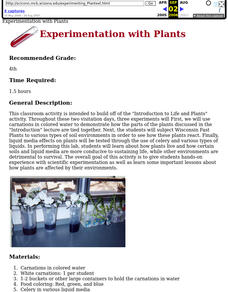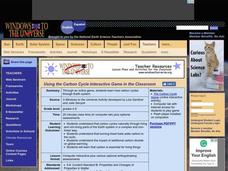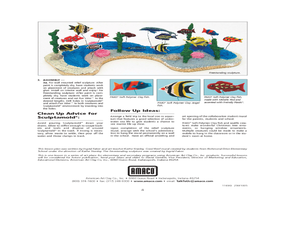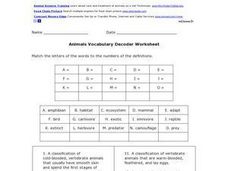Curated OER
Living or Non-Living
Students examine living and non-living things. In this life science lesson, students are given a group of objects and discuss if they are living or non-living. Students identify and list characteristics of living things.
Curated OER
Experimentation With Plants
Fourth graders experiment with different varieties of plants and draw conclusions after performing a series of lab activities. A very helpful student worksheet is given. This is a nicely done introductory lesson for life science.
Curated OER
Tamar Burris
Students explore genetics. In this life cycle lesson, students consider the meaning of "genes" and "heredity" as they watch a video about the topics. Students then research their own genetic make-up as they interview family members....
Curated OER
Jack and the Beanstalk
Third graders read a story and grow a beanstalk. In this literature and life science lesson, the class reads "Jack and the Beanstalk," then lists fairy tale elements and write a puppet show. The students plant pinto beans and observes...
Curated OER
Bone Transformations
Students create a picture from the shape of a bone. In this life science and art lesson plan, students discuss their bones and their purposes, then use a picture of a bone as a starting point for an artistic transformation. Lesson can be...
Curated OER
Using the Carbon Cycle Interactive Game in the Classroom
An online reading and interactive game bring the path of a carbon molecule to life for your earth science explorers! As an assessment, learners can map out or write about their experience in the carbon cycle. Thoroughly written...
Japan Society
A Remade Environment
Art is a wonderful way to express feelings of social unrest or change. Learners will examine the works of two contemporary Japanese artists, and how they each have used art to say something big. They analyze the work of Katsuhiro Saiki...
Norwich Institute for Language Education
Simple Machines
Planning a unit on simple machines? Save some time and energy with this collection of lessons and activities that explores how these devices are used in the real world to make life a little easier.
Curated OER
Taking Count of Biodiversity
Here is a well-designed lesson on biodiversity that should intrigue your charges. In it, pupils compare a natural desert area to a school field to see how habitat destruction affects species diversity. Groups set up transects and collect...
Curated OER
Marine Animal Life Cycles
Fourth graders identify the life cycle of a crab and other marine animals. In this marine life lesson plan, 4th graders complete a crab puppet activity, explore crab moulting, research the life cycle stages of a crab, and identify crab...
Curated OER
Using the Internet to Learn About Marine Life in our Area
Students explore how living things interact with their environment. They research marine life that is studied by Mote Marine Laboratory. Students track sick and injured marine animals. They explore the red tide and the geography of Florida.
Curated OER
Exploring Life in the Coral Reef
Young scholars study life forms in coral reefs. In this ocean life instructional activity, students study life in coral reefs as they create a coral reef sculpture.
Curated OER
Animals Vocabulary Decoder Worksheet
Add some decoding to your scholar's review of basic life science terms in this decorder activity, where students match 15 words to their definitions. Words such as mammal and amphibian must be matched to their written definition. The...
Curated OER
Life Cycle of Animals: Chicken, Duck, Frog
In this animal life cycles worksheet, students complete a ten question true/false assessment pertaining to life cycles of the frog, duck, or chicken. Students draw the life cycle of each animal in a separate box.
Curated OER
Marine Animal and Plant Adaptations
Students examine nature by creating their own animals. In this animal adaptation lesson, students define scientific vocabulary terms dealing with adaptation such as sea stars, sea cucumbers and exoskeleton. Students utilize their...
Curated OER
How Do Animal Life Cycles Vary?
In this animal life cycle worksheet, students will compare and contrast the life cycle of an alligator, insect, and bird. This worksheet is a graphic organizer.
Curated OER
Life Cycles
Young scholars are introduced to the concept of life cycles and identify the growth order and different stages attained by various animals. They view slideshows and video of butterflies and frogs as they change through the various stages...
Curated OER
What Ocean Animals Do Worksheet
In this ocean animals activity, students look at six pictures of ocean animals and then draw a line from each ocean animal to the description that matches it best.
Curated OER
The Life and Times of Guy Fawkes
In this Guy Fawkes activity, students cut apart 8 sentence strips; each tells an event in the life of Guy Fawkes. Students put them in the right order, paste them on a paper, and illustrate each event.
Curated OER
Images of Science
Students understand the diversity of science, both in terms of the work and the people engaged in the work. They learn that some scientists and engineers use huge instruments (e.g., particle accelerators or telescopes), and others use...
Curated OER
WET Science Lesson #11: How Light Affects Water
Scientists listen to the story of Wadja Egnankou who works to save African mangrove forests. They experiment with refraction and the introduction of particulate matter to water. They conclude with creative writing about the need for a...
Curated OER
Marine Habitats of Galveston Island
Four lessons introduce elementary ecologists to salt marsh and sandy beach habitats. In the first lesson, they place shells and other materials in vinegar to determine if they contain calcium carbonate. In the second lesson, they read a...
Curated OER
Bringing the Solar System to Life
Students make models of the planets and use the models to show revolution of the planets around the sun. They explain the rotation of the planets after demonstrating with balloons.
Curated OER
Food & Science - How Healthy is Your Diet?
Learners experiment with various foods to determine fat and starch content. They rub jam, peanut butter, bananas, and other foods in a small circle on a piece of paper, and observe the results. If there is a high fat content in the...
Other popular searches
- 4th Grade Life Science
- Life Science Inquiry
- Life Science Vertebrates
- Life Science Experiments
- K 2 Life Science
- Life Science on Cells
- Life Science Lesson Plans
- Grade 4 Life Science
- Life Science Report Topic
- Australia Life Science
- The Life Science
- Life Science Lessons























